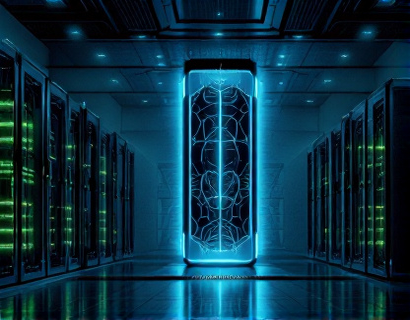Blockchain-Enabled Registry Software: Revolutionizing Data Management
In the rapidly evolving landscape of data management, the integration of blockchain technology has emerged as a transformative force, offering unprecedented levels of security, transparency, and efficiency. This article delves into the realm of blockchain-enabled registry software, exploring how it is revolutionizing the way professionals and enthusiasts approach data management. By leveraging the inherent properties of blockchain, such as immutability and decentralization, this innovative software is redefining the standards for registry management, fostering trust, and optimizing processes across various sectors.
Understanding Blockchain Technology
Before diving into the specifics of blockchain-enabled registry software, it is essential to grasp the fundamental concepts of blockchain technology. At its core, a blockchain is a distributed ledger that records transactions across multiple computers in such a way that the registered transactions cannot be altered retroactively. This technology ensures that once data is recorded, it becomes nearly impossible to modify or delete, providing a high level of data integrity and security.
Blockchain operates on a network of nodes, each maintaining a copy of the entire ledger. Transactions are grouped into blocks, and each block is linked to the previous one through cryptographic hashes, forming a chain. This linkage ensures that any attempt to alter a block would require changing all subsequent blocks, a task that is computationally infeasible. The decentralized nature of blockchain eliminates the need for a central authority, reducing the risk of single points of failure and enhancing resilience against cyber threats.
Enhanced Security through Blockchain
One of the most significant advantages of blockchain-enabled registry software is its ability to enhance data security. Traditional registry systems often rely on centralized databases, which are prime targets for cyberattacks. In contrast, blockchain's decentralized architecture distributes data across a network of nodes, making it extremely difficult for malicious actors to compromise the system. Each transaction is verified through consensus mechanisms, ensuring that only valid data is added to the ledger.
Moreover, the cryptographic techniques used in blockchain provide robust encryption for data, protecting it from unauthorized access and tampering. Smart contracts, self-executing contracts with the terms directly written into code, further automate and secure processes, reducing the risk of human error and fraud. This level of security is particularly crucial for professionals managing sensitive information, such as legal documents, health records, and financial data.
Transparency and Trust
Transparency is another cornerstone of blockchain technology, and it plays a vital role in building trust among stakeholders. In a blockchain-based registry, all transactions are recorded in a public ledger that is accessible to all participants. This transparency ensures that every change or update is visible and verifiable, fostering a high level of trust among users. Unlike traditional systems where data can be manipulated or hidden, blockchain provides an auditable trail that enhances accountability.
For registry management professionals, this transparency means that they can confidently share data with partners, regulators, and clients, knowing that the information is accurate and tamper-proof. This is particularly beneficial in industries where trust and compliance are paramount, such as finance, healthcare, and government. The ability to trace the history of data changes and verify the authenticity of records significantly reduces the risk of disputes and legal issues.
Efficiency and Streamlined Processes
Blockchain-enabled registry software not only enhances security and transparency but also significantly improves efficiency. By automating many manual processes through smart contracts, organizations can reduce operational costs and speed up workflows. For instance, in property registry management, blockchain can automate the transfer of ownership, eliminating the need for intermediaries such as notaries and reducing the time and cost associated with traditional processes.
Additionally, the real-time nature of blockchain ensures that all stakeholders have access to the most up-to-date information. This immediacy reduces delays and errors, streamlining operations and enabling faster decision-making. For IT and software development teams, integrating blockchain into existing systems can lead to more robust and scalable solutions, as the technology inherently supports modular and decentralized architectures.
Use Cases Across Industries
The applications of blockchain-enabled registry software are vast and varied, spanning multiple industries. In the real estate sector, blockchain can simplify property transactions by providing a secure and transparent record of ownership, reducing fraud and streamlining the buying and selling process. In the supply chain, it can enhance traceability and authenticity, ensuring that products meet quality and compliance standards.
In the healthcare industry, blockchain can secure patient records, enabling seamless sharing between providers while maintaining patient privacy. For government and regulatory bodies, blockchain can improve the management of public records, voting systems, and identity verification, enhancing public trust and reducing administrative burdens. In the legal field, blockchain can streamline document management and contract execution, reducing the need for paper-based processes and minimizing the risk of tampering.
Challenges and Considerations
While the benefits of blockchain-enabled registry software are clear, there are also challenges and considerations that organizations must address. One of the primary concerns is scalability. Current blockchain technologies, particularly public blockchains, can face performance issues as the number of transactions increases. However, advancements in blockchain architecture, such as sharding and layer 2 solutions, are addressing these scalability challenges.
Another consideration is the regulatory landscape. As blockchain technology is still relatively new, regulations vary by region, and organizations must navigate these complexities to ensure compliance. Additionally, the adoption of blockchain requires a shift in mindset and processes, which can be a barrier for some organizations. Education and training are essential to help professionals understand the benefits and implement blockchain solutions effectively.
Future Trends and Innovations
The future of blockchain-enabled registry software is promising, with ongoing innovations set to further enhance its capabilities. Interoperability between different blockchain platforms is becoming a focus, allowing for seamless data exchange and integration across various systems. The development of private and consortium blockchains is also gaining traction, offering organizations more control while maintaining the benefits of decentralization.
Furthermore, the integration of blockchain with other emerging technologies, such as artificial intelligence and the Internet of Things (IoT), is opening new possibilities. For example, combining blockchain with IoT can create secure and transparent systems for managing and verifying data from connected devices, revolutionizing industries like smart cities and industrial automation.
Conclusion
Blockchain-enabled registry software represents a significant leap forward in data management, offering enhanced security, transparency, and efficiency. By leveraging the unique properties of blockchain, organizations can build trust, streamline processes, and optimize operations across various sectors. As the technology continues to evolve, its potential to transform registry management and beyond is immense. Professionals and enthusiasts in data management, security, and digital transformation should embrace this innovation to stay ahead in an increasingly complex and interconnected world.










































